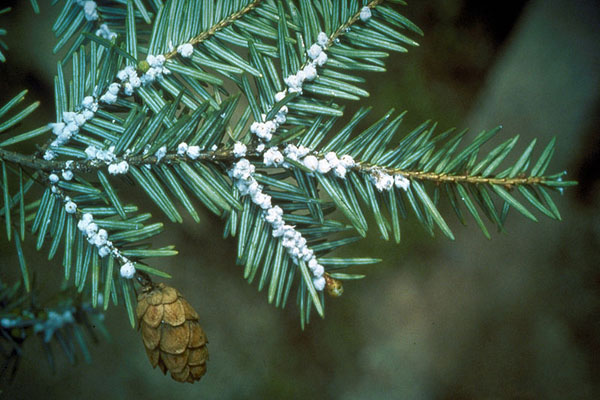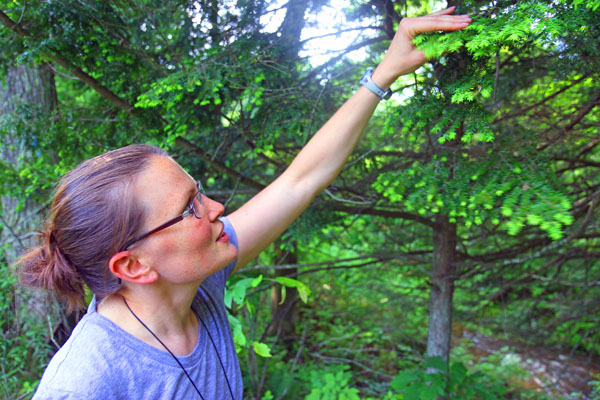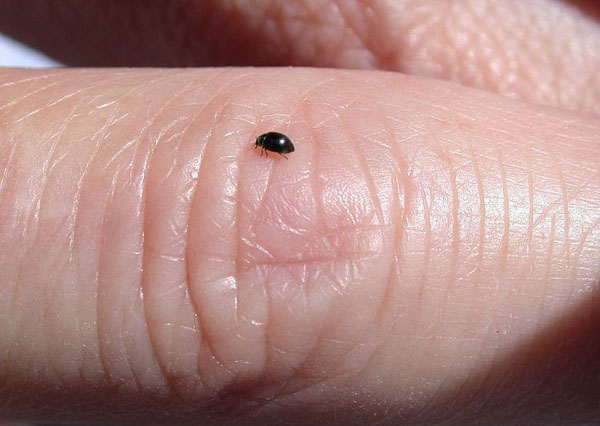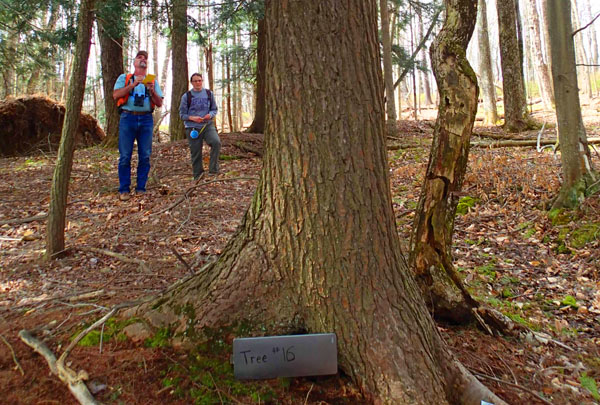Drive along some of the most scenic routes in the eastern United States — Skyline Drive, Shenandoah National Park, the Smoky Mountains – and you’ll see the ghosts of forests past.
Hemlock groves, once some of the most beautiful forests in the country, stand dead and dying. They’re the victim of a tiny, invasive pest that’s raging through trees.
The rapid loss of trees can leave the most optimistic conservationist feeling hopeless. And indeed, there is not enough time or money to save all the hemlocks.
By mapping hemlocks, identifying trees that are most vital ecologically and using a variety of pest management techniques, forest conservationists are finding that they can ensure that hemlocks remain a part of the eastern forest.
Perhaps ironically, one of the focal points in testing these techniques is at a forest preserve where management activities were expressly forbidden when the preserve was donated by a conservationist in 1954.
The Nature Conservancy’s Woodbourne Forest Preserve in north-central Pennsylvania was to be a place where nature ran its course. And where old-growth hemlocks thrived. In 2014, those two goals are incompatible.
“To say we’re not going do anything and just let the forest alone is not a viable option if we want a healthy eastern forest,” says Don Eggen, Division Chief of the Forest Pest Management Division for the Pennsylvania Bureau of Forestry. “Just look at the invasive species out there. They’re coming. Some of them are already here.”
Fortunately, the donor of the property specified that management could be undertaken when unforeseen circumstances arise. And that circumstance comes in the form of a tiny but devastating insect: the hemlock woolly adelgid.

Death in the Hemlock Grove
The hemlock woolly adelgid (HWA) – native to Japan – was first documented in the United States in 1951, but it has begun its rapid spread in the past twenty years.
It punctures hemlock needles to suck out nutrients, killing the tree in five to ten years. It can be seen on hemlock trees as a cottony mass under the needles – a depressingly familiar sight over most of the tree’s range.
There are many non-native forest pests in North America, of course (you can read the full and sobering account in the recent report Fading Forests). And such pests aren’t new: in the early 1900s, the American chestnut became functionally extinct due to chestnut blight.
The hemlock woolly adelgid is perhaps even more vexing.
Unlike many eastern forest trees, there’s no species that can replace its ecological function. Hemlock groves provide habitat for a variety of birds and their shade keeps streams cool for native fish.
They’re also aesthetically pleasing. An old-growth hemlock grove, brook babbling between arching evergreen limbs and deep green moss, is pretty close to the enchanted forest of fairy tales.
Now this state tree of Pennsylvania is disappearing, a tough loss ecologically and culturally. But the latest forest science brings hope.

Map, Identify, Control
The Nature Conservancy is working on a comprehensive effort with more than 50 partners to develop a strategy to save the hemlock.
This effort is known as The High Allegheny Hemlock Conservation Strategy, and is focused on northwestern Pennsylvania and western New York.
There are already excellent data on hemlocks. Previous efforts have mapped existing hemlock forests and their susceptibility to HWA, based on abundance and potential for introduction.
The new partnership has used existing data to develop a technique to prioritize hemlock forests that are most at–risk and have highest conservation value. One of the priority landscapes has been the Allegheny National Forest, a large, public forest with lots of hemlocks.
Smaller forests are important, too. Woodbourne Forest Preserve, at 650 acres, may seem inconsequential. But it offers a great test site.
“Woodbourne became a priority due to the old-growth hemlocks, one of our priorities,” says Sarah Johnson, GIS conservation specialist for the Conservancy. “Its size allows us to test options and develop pest management strategies that can make a difference.”
HWA was first found on the preserve five years ago along the edges; today it has been confirmed in the interior of the preserve. But trees that have the disease can be treated. The problem is, treatment is expensive, and it’s not a one-time solution.
“If you start treating trees, you can’t really stop, or you’re just wasting money,” says Johnson. “We need to prioritize the trees that we will focus on saving. We need that prioritization so that we can continue to treat them.”
Hemlocks don’t occupy the entirety of Woodbourne. They’re not even the dominant tree (but lose the hemlocks, and the entire ecological function and health of the forest changes forever).
The pockets of hemlocks on the preserve have been delineated, but that’s just the first phase of the project.
“We could circle each grove of hemlocks and say that we’re done. That would be the easy way,” says Johnson. “But it’s more meaningful if we consider other factors. Where are hemlocks shading stream corridors? Where is the greatest diversity? What is the understory like?”
Next comes inventorying every tree – each hemlock is tagged, tallied and recorded via GPS. The scientists are looking for a selection of trees that gets at a representative mix of a hemlock grove – representing all age classes and different habitats.
In 2015, the selected trees will be injected with a pesticide. Those trees will be treated every three years until the disease is better controlled by non-chemical means – which could be a long ways into the future.
“There’s a lot to think about when you’re using chemicals,” says Johnson. “We want to focus our efforts on those trees where we can make the most difference using the least amount of chemical.”

Hope in a Beetle
But chemical treatment is only a partial solution: after all, it will only impact injected trees, and the number of trees selected is limited due to cost.
The Conservancy is also investigating longer-term strategies to protect the trees. Enter a beetle that eats the invasive adelgid.
Releasing another non-native species might sound risky, but such species – called bio-control insects – are thoroughly tested before release. The beetle could conceivably help keep the adelgid in check. But it needs just the right amount of adelgids to become established: too few, and the beetle starves. Too many, and the beetle can’t really make a difference.
“Our goal is to put chemicals on selected trees, while putting beetles on trees not being treated,” says Johnson. “The goal is to manage the adelgid so that hemlocks can survive. We have to learn to live with the pest. We’re never going to get rid of it completely.”
HWA breeds rapidly, so this variety of methods will be essential to make a difference. “You have to kill 91 percent of the population of HWA each year to just keep its population stable,” says Johnson. “Any less than that, and the population grows.”
Woodbourne has a preserve committee of local landowners and community members that has overseen its management since 1956. They have taken the charge to protect the forest seriously, and only allow management if it is necessary to protect the integrity of the forest. While some forest management issues have been contentious, this is not one of them.
“We want to give the committee a variety of options for pest management,” says Johnson. “We want to consider all the methods available and integrate them to have the most lasting impact. But the committee realizes we won’t be able to save all the trees.”

Help from Nature
There’s one more factor that can help in the fight to save hemlocks: cold winters.
During sustained frigid temperatures that average 23 degrees Fahrenheit between December and March, the hemlock woolly adelgid perishes. (It should be noted that this cold weather also kills the bio-control beetle). Last year’s polar vortex appears to have hit the invasive hard.
It so far has helped keep the pest at bay in the northern parts of its range, unlike warmer places like the Smoky Mountains. That buys time. But for how long?
“Cold winters are saving us,” says Don Eggen of Pennsylvania’s Bureau of Forestry. “But what happens when it warms up? Go a little farther south and you’ll see the answer in the form of dying hemlocks. It’s not pretty.”
That’s why conservationists can’t just sit around and hope for colder winters. They need to continue to develop new methods. Unlike some invasive pest situations – where the pests adapt quickly to new control methods – people have the chance to win this race.
“Hemlock woolly adelgid has very low genetic diversity,” says Johnson. “That makes them very slow to adapt. As far as we know, they have so far not adapted well to colder weather, or developed pesticide resistance.”
Testing these methods on a small forest preserve has an added benefit: it makes it more relevant to Pennsylvania’s private landowners. More than 70 percent of Pennsylvania’s forest is privately owned by more than 750,000 landowners. Most of those are small parcels.
Creating useable methods that can be applied by small forest owners will be a key component of saving iconic hemlocks.
“At Woodbourne, you can address what hemlocks to prioritize for protection,” says Eggen. “It is not only an opportunity for active management, but also an opportunity for education, demonstration and outreach.”
“Hemlocks are important to Pennsylvanians,” says Johnson. “Right now, a lot of the news has been pretty bleak when it comes to this tree. But we are working with partners to develop innovative solutions. We want to show a difference at Woodbourne. And we want to be able to show other landowners how to replicate that on their properties.”
Editor’s Note: This is the third installment in a five-part series on the challenges of eastern forest conservation in the Anthropocene.
Read the previous blogs.




Join the Discussion
4 comments